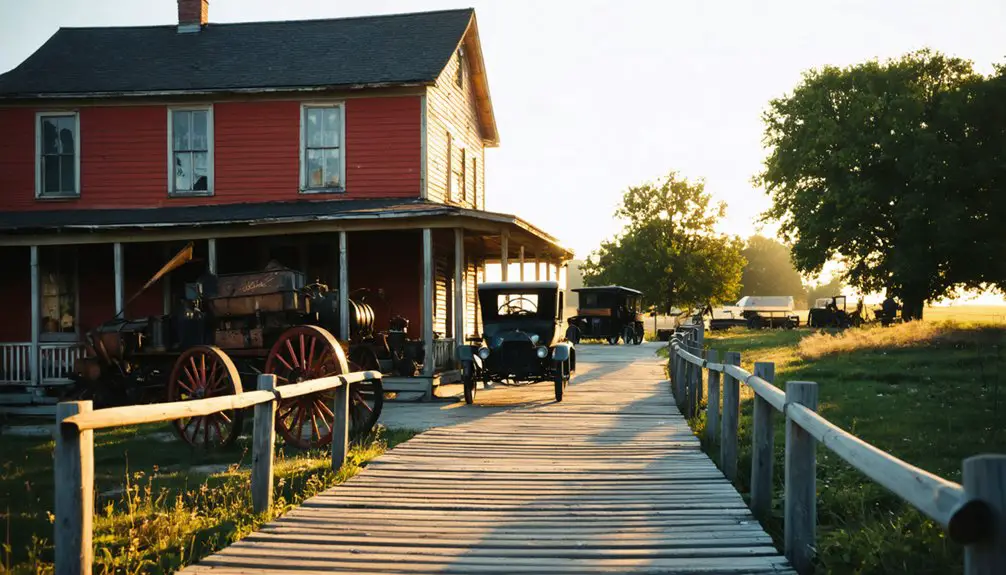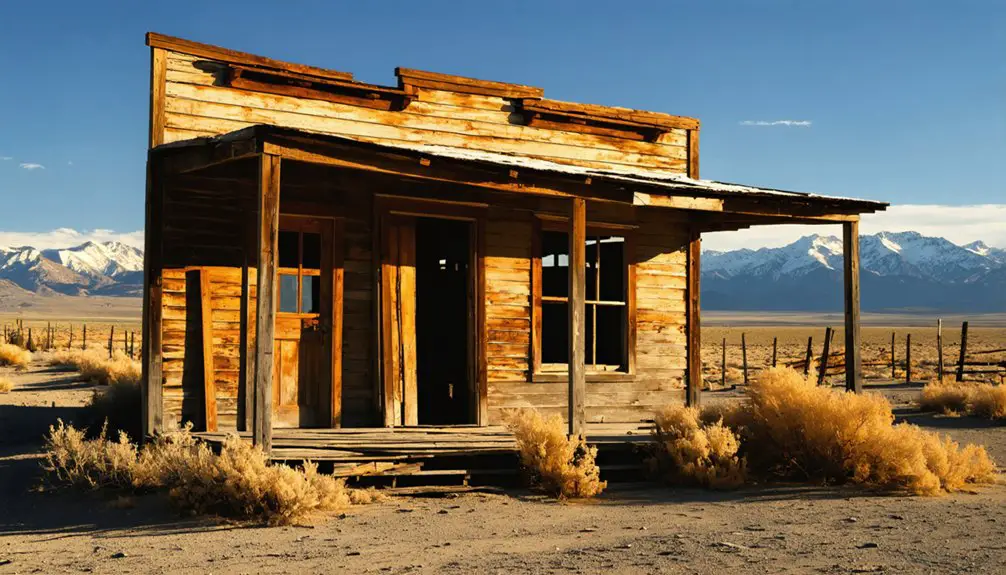You’ll find Molson, Washington perched at 3,708 feet, where gold-rich ore sparked a rush in 1896. After land disputes forced relocation in 1909, New Molson emerged as Washington’s highest railroad town, booming to over 1,000 residents. By the 1930s, the Great Depression ended rail service, transforming this once-bustling hub into a ghost town. Today, the Molson Museum complex preserves pioneer buildings and farming artifacts, offering glimpses into its golden past.
Key Takeaways
- Molson started as a gold mining town in 1896, growing from 12 settlers to 300 prospectors before transitioning to an agricultural community.
- The town relocated in 1909 due to land disputes, establishing New Molson half a mile north at 3,708 feet elevation.
- During its peak in the 1910s, Molson’s population exceeded 1,000 people and became the largest freight shipper between Oroville and Spokane.
- The Great Depression and railroad removal in the 1930s led to Molson’s decline and eventual ghost town status.
- Today, the Molson Museum complex preserves the town’s history through original buildings, mining artifacts, and a three-story schoolhouse museum.
The Gold Rush Origins and Town Establishment
When gold-rich ore was discovered in 1896 near what would become Molson, Washington, the area transformed from a remote outpost of just a dozen settlers into a bustling frontier town of 300 prospectors.
You’ll find the town’s founding clouded in competing claims – some credit George B. Meacham, who established Molson in 1898 with backing from Canadian brewing magnate John W. Molson, while others point to the Leckner brothers’ efforts in 1900.
Despite the prospector challenges of harsh terrain and limited success – only one mine proved profitable – mining aspirations drew waves of fortune seekers and entrepreneurs.
The arrival of the railroad line in 1901 further accelerated the town’s development and population growth.
The town quickly sprouted saloons, hotels, and even its own newspaper, “The Molson Leader.”
The financial backer withdrew support after determining the gold supply couldn’t sustain long-term operations.
Positioned strategically near the Canadian border, Molson emerged as an essential trading hub for the region’s early settlers.
Relocation and the Birth of New Molson
The fate of Old Molson took an unexpected turn after J.H. McDonald homesteaded the townsite and issued an eviction order in April 1909. Rather than fight over land ownership, the residents made a bold community decision to relocate entirely.
In 1909, faced with eviction, Old Molson’s residents chose unity over conflict, making the remarkable choice to relocate their entire community.
You’ll find that New Molson emerged just half a mile north, strategically positioned across the railroad tracks at an elevation of 3,708 feet – the highest railroad station in Washington State. The town’s businesses, residents, and even the post office packed up and moved to this fresh start. Much like how John Molson founded his brewery in Montreal in 1786, the town pioneers showed remarkable entrepreneurial spirit in establishing their new settlement. The settlement quickly grew into a vibrant community with twenty-stamp mills and mines operating in the surrounding area.
While New Molson initially thrived as an agricultural hub with strong railroad connections to Spokane, its prosperity wouldn’t last. Despite being briefly incorporated in 1920, the town faced challenges when the Supreme Court invalidated its status in 1921.
Later, the Great Depression struck, leading to the railroad’s removal by the mid-1930s.
Railroad’s Rise and Fall
When you look at Molson’s peak railroad years, you’ll find it was the largest freight shipper between Oroville and Spokane, moving an impressive 125 railroad carloads of goods in 1917 alone.
The Great Northern Railroad’s presence transformed this former mining camp into a bustling commercial hub, with its station standing proudly as Washington state’s highest at 3,708 feet. During this prosperous era, local car dealers sold various popular brands including Ford, Dodge, and Buick. The town’s population flourished with over 1,000 residents during these early 1910s.
Yet by the mid-1930s, the devastating effects of the Great Depression led to the complete removal of the tracks, forever ending Molson’s glory days as an essential shipping center.
Peak Railroad Operations
Following its arrival in late 1905, the Great Northern Railway transformed Molson into a bustling railroad hub, establishing twice-daily passenger service by 1907 and positioning the town’s station as Washington State’s highest-elevation stop.
The railroad’s influence brought unprecedented economic growth, with infrastructure expansions supporting major operations. You’d find:
- A thorough rail yard with water tank and wye track for turning trains
- Regular service connecting Bridesville, BC (5 miles northeast) to Nine Mile, WA (7 miles west)
- A strategic position along the 68-mile Curlew-Oroville route, with 29 miles through Canadian territory
Molson’s challenging terrain, particularly the steep Molson Hill descent toward Oroville, tested engineers’ skills but didn’t hinder the town’s emergence as an essential transportation nexus supporting mining, logging, and agricultural industries throughout the region. Much like the Molson steamboat fleet of Canada’s early days, the railroad played a crucial role in regional transportation and commerce. The railroad’s prosperity lasted until ore deposits depleted in 1935, leading to the end of rail service.
Tracks Removed Forever
Despite Molson’s meteoric rise as a railroad hub, its golden age of rail service lasted just three decades.
You’ll find that the Great Depression dealt the fatal blow, making rail operations unsustainable in this remote corner of Washington state. The railroad’s death came in stages – first with the Molson-Oroville track abandonment in 1931, followed by the removal of the Curlew-Molson segment in 1935.
The completion of direct rail service by 1913 had initially brought promise and connectivity to the region. What was once the highest elevation station on the Great Northern Railway line turned into a ghost town, stripped of its bustling depot, wye, water tank, and yard facilities.
Today, only historical remnants hint at Molson’s railroad glory days. The town transformed from an essential transport center into a quiet agricultural community, its identity forever changed by the tracks’ removal.
From Mining Hub to Agricultural Community
As Molson’s gold mining prospects dimmed in 1901, the town underwent a dramatic change from a bustling mining hub into an agricultural settlement.
The economic shift wasn’t easy – you’d have seen the population plummet from 300 to just a dozen residents in mere months. Yet, community resilience shone through as remaining settlers adapted to new opportunities.
Three key changes shaped Molson’s agricultural future:
- The arrival of the Great Northern Railway in 1905 opened doors for farming transportation.
- Residents strategically relocated to “New Molson” near the railroad tracks.
- Families switched from mining to ranching and farming the Okanogan Highlands.
You’ll find that while mining operations faded by 1938, the town’s agricultural identity took root, though modest in scale compared to its gold rush heyday.
Preserving History: The Molson Museum Today

Today, the rich heritage of Molson lives on through its remarkable museum complex, established in 1960 by local resident Harry Sherling.
You’ll find authentic pioneer buildings, including the old bank, assay office, and saloon, alongside an impressive collection of historical artifacts from the region’s mining and farming past.
The centerpiece of the complex is the three-story red brick schoolhouse, which opened as a museum in 1982.
Through dedicated community engagement, volunteers staff the facility from Memorial Day to Labor Day, offering guided tours and sharing firsthand historical knowledge.
You’re free to explore the grounds year-round during daylight hours, wandering through original streetscapes and examining farming equipment. The museum’s fascinating farming machinery displays tell the story of the area’s agricultural evolution.
While there’s no admission fee, you can support preservation efforts through donations and enjoy homemade pastries with fresh-brewed coffee during your visit.
Life in Washington’s Highest Railroad Town
The rugged mountain town of Molson carved out its place in history as Washington state’s highest railroad stop, perched at an impressive 3,700 feet near the Canadian border.
Perched high in Washington’s mountains at 3,700 feet, Molson stands as a testament to railroad history near Canada’s edge.
You’d have witnessed remarkable community dynamics as the town transformed from a small mining settlement into a bustling railroad hub after 1905. The Great Northern Railway’s arrival sparked new economic resilience, turning Molson into an essential stopover between Spokane and British Columbia.
Life in this mountain town centered around:
- The New Imperial Hotel’s 23 rooms, hosting weary railroad workers and travelers
- Vibrant entertainment venues, including a local theater
- Multiple businesses, from saloons to professional services, serving a growing population
Despite land disputes forcing residents to relocate to New Molson, the community’s pioneer spirit persisted until the Great Depression.
Frequently Asked Questions
What Happened to the Molson Hotel Tonasket After the 1924 Fire?
Like a phoenix that never rose, you won’t find the Molson Hotel Tonasket standing today. After the devastating 1924 fire destroyed it completely, the hotel was never rebuilt or replaced.
Are There Any Descendants of George B. Meacham Still Living Nearby?
You won’t find documented Meacham heritage or family connections in the area today. Despite George B. Meacham’s role as founder, there aren’t any confirmed descendants living near the former town site.
How Much Gold Was Actually Extracted From the Molson Mines?
You won’t find exact figures for Molson’s gold mining output – historical records don’t document specific quantities. While Washington State produced around $10 million in early gold, Molson’s contribution remains mysteriously unrecorded.
What Native American Tribes Originally Inhabited the Molson Area?
You’ll find the Okanogan tribe primarily inhabited this area, while the Methow, San Poil, Nespelem, Lakes, Colville, Calispel, Spokane, and Coeur d’Alene tribes shared the broader region’s Native American cultural heritage.
Can Visitors Stay Overnight in Any of the Remaining Buildings?
You can’t stay overnight in the ghost town accommodations – they’re maintained strictly for historic building preservation and daytime tours. Instead, you’ll find comfortable lodging options in nearby Oroville.
References
- https://www.thesuncoveresort.com/molsonghosttown
- http://www.ghosttownsusa.com/molson.htm
- https://en.wikipedia.org/wiki/Molson
- https://theruggedsociety.com/en-us/blogs/news/rugged-roads-old-molson-washington
- https://westernmininghistory.com/towns/washington/molson/
- https://www.onlyinyourstate.com/state-pride/washington/left-in-ruins-wa
- https://molsonmuseums.org/about/
- https://molsonmuseums.org/history/
- https://www.hmdb.org/m.asp?m=154989
- https://www.wikiwand.com/en/articles/Molson



